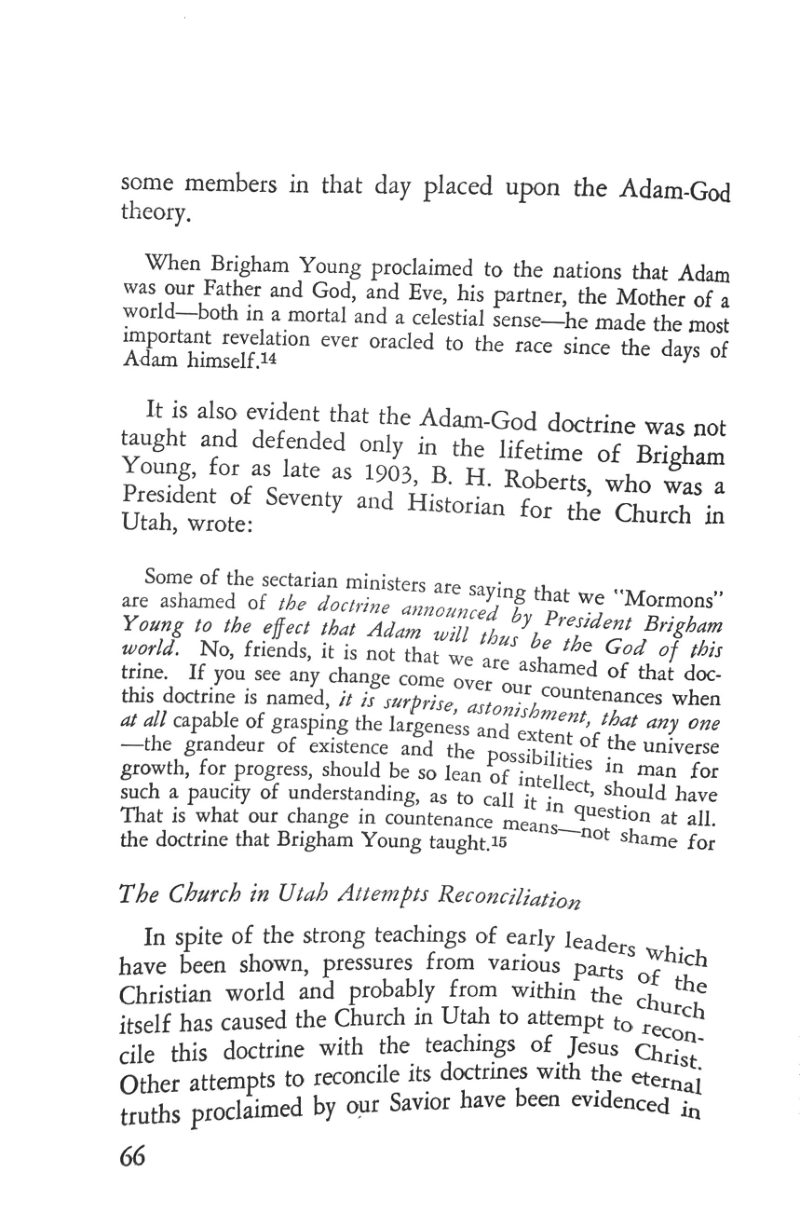Russell F. Ralston (RLDS) discusses the LDS attempt to downplay Brigham's Adam-God teachings; provides a brief overview of RLDS understandings of Adam and God.
- Type
- Book
- Source
- Russel F. Ralston CriticNon-LDS
- Hearsay
- DirectReprint
- Reference
Russell F. Ralston, Fundamental Differences between the LDS and RLDS Churches (Independence, Missouri: Price Publishing Company, 1998), 66-69
- Scribe/Publisher
- Price Publishing Company
- Audience
- Reading Public
- Transcription
The Church in Utah Attempts Reconciliation
In spite of the strong teachings of early leaders which have been shown, pressures from various parts of the Christian world and probably form within the church itself has caused the Church in Utah to attempt to reconcile this doctrine with the teachings of Jesus Christ. Other attempts to reconcile its doctrines with the eternal truths proclaimed by our Saviour have been evidenced in preceding chapters. Attention is now called to the attempt of the Church in Utah to absolve itself of connection with the Adam-God doctrine.
In 1921, the Presbyterians in Salt Lake City published “Ten Reasons Why Christians Cannot Fellowship with the Mormon Church.” These are noted in the Deseret News of July 8, 1921. The sixth of the ten reasons was:
The Mormon Church teaches that Adam is God, the Supreme God, the Creator of this world, our God, and the only God with whom we have to do; and that Jesus is his son by natural regeneration.
B. H. Roberts, Utah Church Historian, endeavored to answer these charges and in the Deseret News of July 23, 1921, we find the following regarding the charge noted in the previous statement:
As a matter of fact the “Mormon” Church does not teach this doctrine. A few men in the “Mormon” Church have held such views, and several of them quite prominent in the Councils of the Church. . . . Brigham Young, and others may have taught that doctrine, but it has never been accepted by the Church as her doctrine.
As noted earlier, young missionaries of the Church in Utah who are not well acquainted with some of the historical facts of their movement deny that any of their leaders ever taught such a doctrine, but Mr. Roberts feely admitted that men “prominent” in the leadership of his church did teach the doctrine as charged. He did deny the charge that the church as such ever accepted it. This denial is most inconsistent with his statement of 1903 when he expressed astonishment that anyone who understands God at all could have been so “lean of intellect” as to even question the Adam-God doctrine. When was Mr. Roberts right—when he defended this doctrine or when he denied that his church ever accepted it?
If the latter statement of Mr. Roberts is correct and the Church in Utah did actually refuse to accept this far-reaching doctrinal concept of Brigham Young then the people of that church did at this point repudiate the man who of all men was most responsible for their movement in the valleys of Utah.
Whether or not the Church in Utah did in effect formally accept the Adam-God doctrine is not too important. The fact still remains, as shown in a previous chapter, that it teaches men living today can literally fulfill everything that Brigham attributed to Adam; for if, as taught by the Church in Utah, men can become Gods and create and populate their own worlds, then they can become Gods of those worlds just as Brigham said Adam is of this world. It is to be noted, then, that while the Church in Utah has attempted to remove the distasteful implication of the term “Adam-God,” it still teaches the fundamental principles which underlie that theory.
The Reorganized Church Belief
In contrast to this departure from truth so vigorously proclaimed by the early leaders of the Church in Utah, the Reorganized Church with its leaders has always held to the “rod of iron.” The Reorganized Church has consistently rejected the theory that (1) Adam lived previously on another planet; (2) we are the “spiritual children” of Adam and “his wives” in the “spirit world”; (3) Adam is our Father-God-Creator, and “the only God with whom we have to do.” The Reorganized Church cannot accept as true apostles and prophets men who taught such doctrine even though they did claim these things were “revealed” to them by God.
The Reorganized Church is bound in this, as in all other teachings, to keep its doctrine consistent with the teachings of the Bible, Book of Mormon, and Doctrine and Covenants. It has always positively affirmed that there is but one God, that he is infinite and eternal, and that he is the only God with whom nan or the universe has to do.
- Citations in Mormonr Qnas
The B. H. Roberts Foundation is not owned by, operated by, or affiliated with the Church of Jesus Christ of Latter-day Saints.

